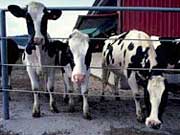|
Photos
Your Voice
|
One man's solution: Loosen regulations of dairy farms
April 14, 2003
 |
| Charles Hann (MPR Photo/Mark Steil) |
Minneapolis, Minn. — It grieves me -- as a Minnesotan -- to say this, but I have a very hard time recommending Minnesota as a location to anyone interested in building or operating a modern dairy farm. When compared to the 10 upper Midwest states -- by which I mean the states north of Missouri and Kansas, and bordered by Michigan and Ohio to the east and the Dakotas and Nebraska to the west -- when compared to these states, I have to rank Minnesota near the bottom -- if not last -- as a place in which to start or operate a dairy farm business.
Statistics indicate that this is also the view of most people in the dairy industry. For the year 2002 relative to 2001, milk production in Minnesota, according to all sources, suffered a further decline, continuing a 20-plus year trend. Production in the other Midwest states as a group held constant, and nationally, production increased 2.7 percent.
To be more specific, Minnesota production, according to USDA statistics, declined by 354 million pounds, or 4 percent, the largest production decrease of any of the principal producing states in the upper Midwest.
For comparison -- again for 2002 relative to 2001 -- production in Illinois, Indiana, Iowa, Michigan, Nebraska and Ohio increased, and production in Iowa and Wisconsin held about flat. In the case of Michigan and Ohio together -- in which production a few years ago was about the same as Minnesota's and is now 23 percent higher -- production increased by 2.5 percent, or slightly less than the national average.
Before going any further, as background, I should point out that for more than 30 years, I have specialized in business project financing -- and in the identification of investment opportunities associated with project financing -- in several national industries.
|
If action is not taken to effect the changes in Minnesota's dairy farm business climate, the decline is sure to continue -- while milk production and related milk processing proceeds to grow in other upper Midwest states.
- Charles Hann |
Until about 10 years ago, I had had no connection with the dairy industry. I first started looking in the dairy faming business when I learned that, what was then the largest segment (dairy foods) of Minnesota's largest industry (agriculture) was in serious decline, and Minnesota was rapidly losing market share. Clearly, something significant appeared to be happening. And whatever it was, I speculated, might possibly mean a business opportunity. I decided to learn what was going on.
Ordinarily, losing a major business would be a matter of grave concern to business and political leaders in the state, if not newspaper editors. And the fact that it was hardly being noticed in the news accounts of that time seemed very strange. To the extent newspapers covered anything about the dairy industry, the coverage was typically anecdotal with a focus on marginal producers. It caused me to wonder what I was failing to understand.
Perhaps, I speculated, the upper Midwest was just not a good place for milk production and other parts of the country had important economic advantages. When I looked into this possibility, I soon found it not to be the case at all.
In fact, experts easily showed me that the upper Midwest has significant economic advantages over other areas, and, when all factors are considered, is an outstanding -- perhaps the best -- region in North America for profitable milk production. Even our climate, I learned, is a positive when compared to major milk producing states in the southwest and west.
In connection with this, I started to learn what was happening in other states -- in the upper Midwest as well as other regions of the country.
While all states in the upper Midwest experienced a drop in milk production and in market share in the last quarter of the 20th century, not all have continued to decline. The more I learned about the 10 states comprising the upper Midwest, the more evident it became that -- while there many similarities -- there were significant differences in what was happening in each state.
In other words, while the underlying economic advantages of the upper Midwest as a region -- as well as factors causing the initial decline -- were essentially the same for all upper Midwest states, the vitality of the dairy farm business varies considerably from state to state. And, especially disappointing, it became evident that the vitality of dairy farms in Minnesota is lagging all principal producing states in the upper Midwest.
I had to conclude that the differences in dairy farm vitality between states in the region -- including the difference between Minnesota and other nearby states -- could only mean that there must be some critical factors related to the differences in the dairy farm business environment in each state.
Let me interject here that -- as a result of our findings -- investors with whom I have been associated for the past several years concluded that the milk production segment of the dairy industry might indeed constitute an interesting business investment opportunity. And members of the group have been actively seeking out owners of superior family dairies for a possible investment association.
While state loyalties cause us to want to seek dairy farms desiring to operate in Minnesota, our business judgement directs us elsewhere. As a consequence, we have concentrated -- and are continuing to concentrate -- our efforts outside Minnesota, which -- as I said at the start -- grieves me to admit.
In principle -- I think it is accurate to say -- the factors under the heading of business environment for dairy farms in Minnesota are not materially different than such factors that, too frequently, adversely affect all small businesses in Minnesota. But, I don't want to generalize. Instead, I will comment only to a few of the factors specific to the dairy business.
While undoubtedly well intentioned, Minnesota's anti-corporate farming law is clearly an impediment to sound capitalization of the type required for a successful business -- the type of capitalization available to and used by all non-farming businesses.
The law, and the prevailing mindset which created and perpetuates the the law, leads almost inextricably to excessive debt leverage, inability to service debt and -- too frequently -- financial failure of a dairy farm. The prevailing mindset -- and the law -- causes dairy farms, as well as production agriculture in general, to be among the most highly leveraged businesses in Minnesota.
The most egregious aspects of the law have been somewhat mitigated over the years by various legislative actions. And, with skillful legal assistance -- not always available to a dairy farm owner-- and at significant legal expense, it is possible to completely skirt the effects of the law.
Only four other upper Midwest states have somewhat similar laws. None of the remaining upper Midwest states, and none of the major producing states in the southwest and west have such restrictive provisions on dairy capitalization.
Minnesota's environmental and health regulations relating to milk production are among the most highly developed of any state in the nation, and are consistent with such regulations existing in other upper Midwest states. They are generally technically sound and not unreasonable. Well-managed dairy farms ordinarily find their operations easily meet the minimums required for compliance. Typically, only poorly managed and old style operations have compliance problems.
While state regulations affecting dairies are generally reasonable -- even business-like -- other practices related to the manner in which dairy farms are actually regulated in Minnesota are at best very unreasonable and unbusinesslike -- if not outrageous.
Understand, first, that in order to construct a modern milk production facility, or to improve an existing facility (in all except a very small operation), requires an approved construction plan and a state-issued permit. This is true in every upper Midwest state.
In addition to meeting state-defined specifications, an applicant for a dairy farm permit must also participate in all aspects of the permitting process, which includes public hearings and consents from local government bodies. Plans and documentation to secure such a permit -- including engineering and legal expenditures -- runs upward from $50,000, and may total several hundred thousand dollars.
Having secured a construction permit -- in all upper Midwest states except Minnesota -- an owner of a dairy farm is able to proceed to build and operate in accordance with the provisions of the permit and relevant state regulations.
Minnesota is the only state in which state laws allows a township or a county board -- after a dairy farm has secured the required state permit -- to prevent the dairy owner from going ahead with construction in accordance with the state permit. Although a township or county board consented as part of the permitting process, and only in Minnesota, either may later act to halt the project.
Only in Minnesota, in other words, is a state permit subject to being overruled -- after issuance -- by a change in the vote of a few members of a township or county board. It should be obvious that no business which relies upon the sanctity of contracts can operate under such a condition.
While dairy farms, as well as enforcement agencies, in all states are subject to public abuse by small groups of people acting under some federal or state regulation, the intensity of such action varies greatly from state to state. The difference can only be accounted for by differences in the dairy farm business environment in each state.
While it is painful to acknowledge, I have to admit the intensity of opposition to dairy farm operations -- typically on some environmental grounds -- and then, the consequent cost of such opposition -- is significantly greater in Minnesota than in any other upper Midwest state.
There is more, but it should be obvious, with just these examples, that there are valid reasons for the greater decline of milk production in Minnesota when compared to other upper Midwest states. If action is not taken to effect the changes in Minnesota's dairy farm business climate, the decline is sure to continue -- while milk production and related milk processing proceeds to grow in other upper Midwest states.
During the past 20 years, there has been a steady drop in Minnesota production of milk, butter, powdered dry milk, cheese and whey products, and only minimal capital investment in new processing facilities. In fact, a number of cheese plants have closed because of declining milk production. Most capital investment -- even by Minnesota-based manufacturers -- is going to other states.
We are in grave danger of witnessing the demise of Minnesota's once great and proud dairy foods industry. Thousands of jobs are being lost due to the continuing decline of the industry.
If steps are not taken quickly to change the dairy farm business environment in Minnesota, it is predictable that the dairy industry in Minnesota will be reduced to little more than a small fluid milk business to satisfy local consumption.
As I said at the outset, it grieves me greatly to have to say what I have said. But, perhaps my comments may help bring forward other more authoritative voices -- not only to speak out, but also to provide the leadership needed to initiate corrective steps to change Minnesota's business environment -- to cause the people of Minnesota to once again demonstrate that we are really as progressive as we like to assert that we are.
|
News Headlines
|
Related Subjects
|

